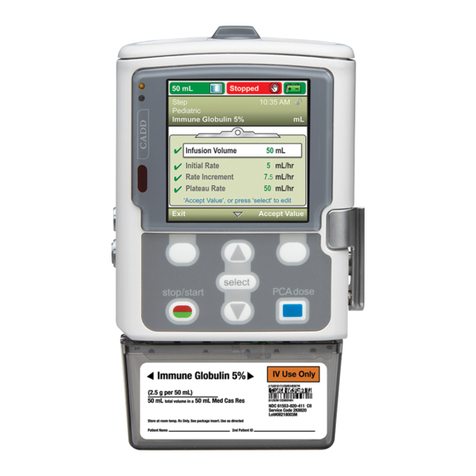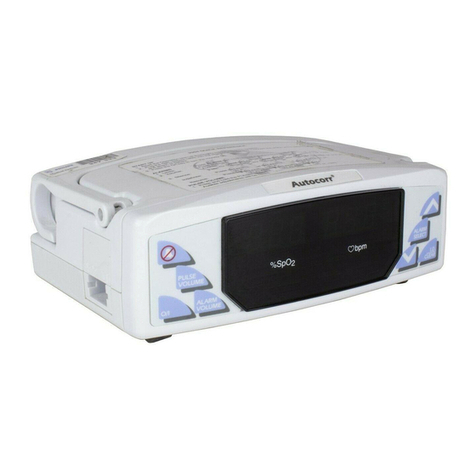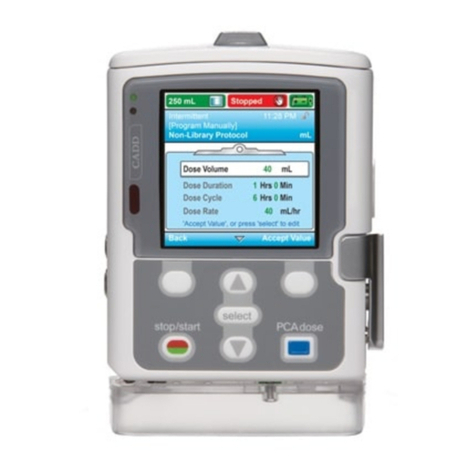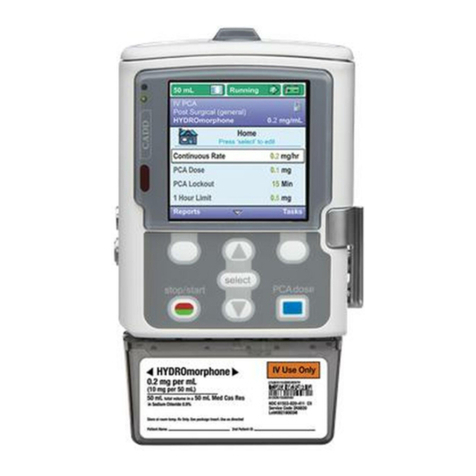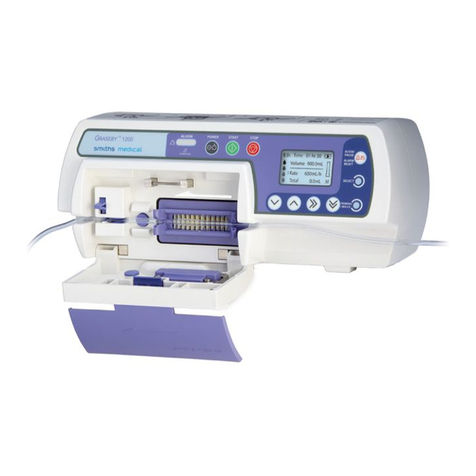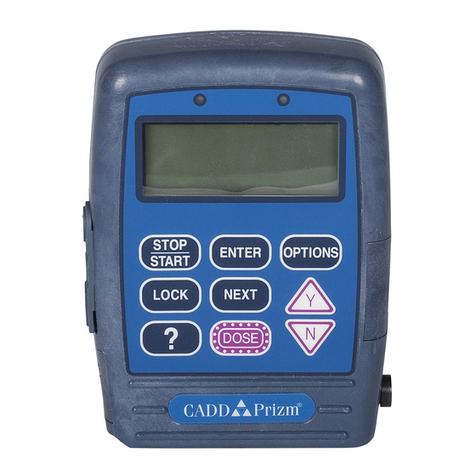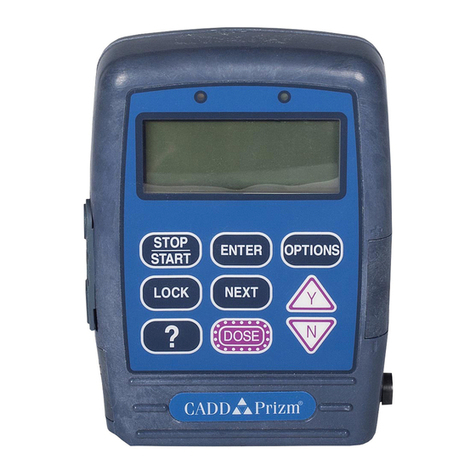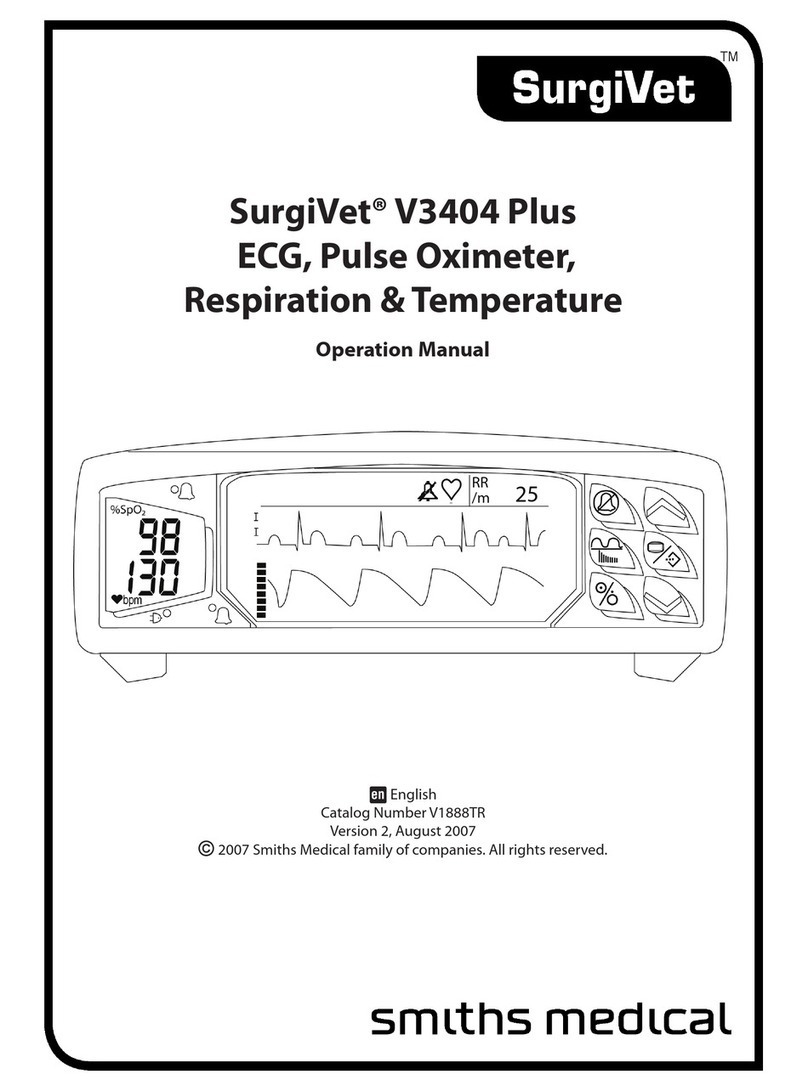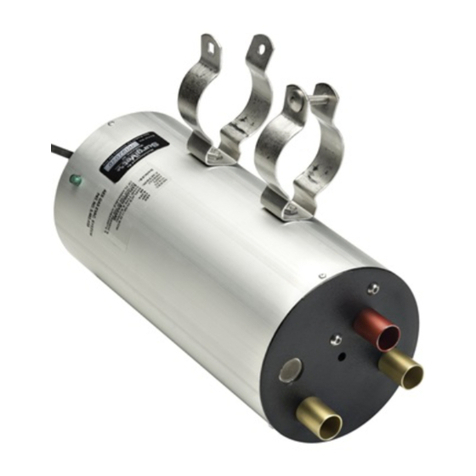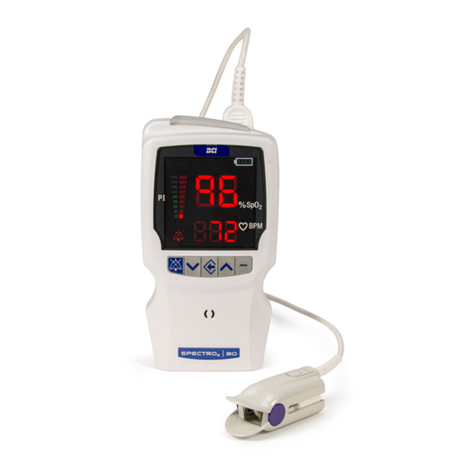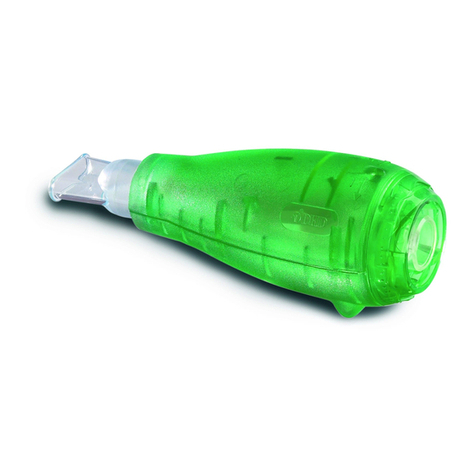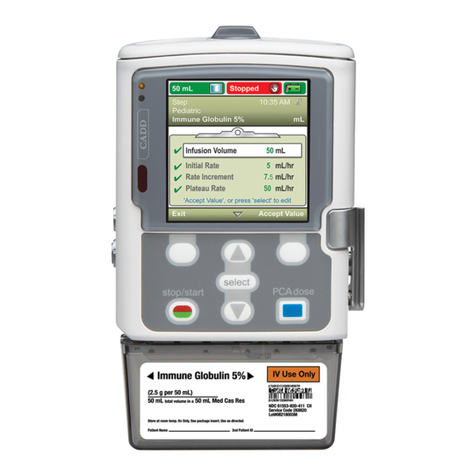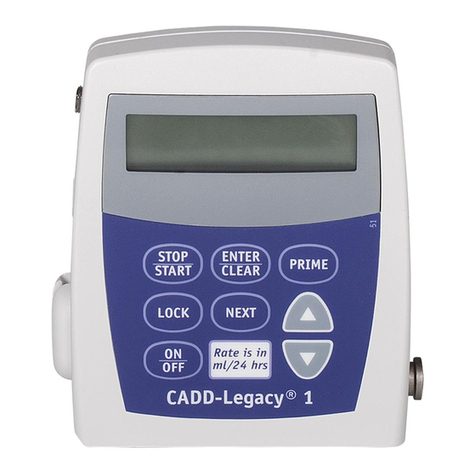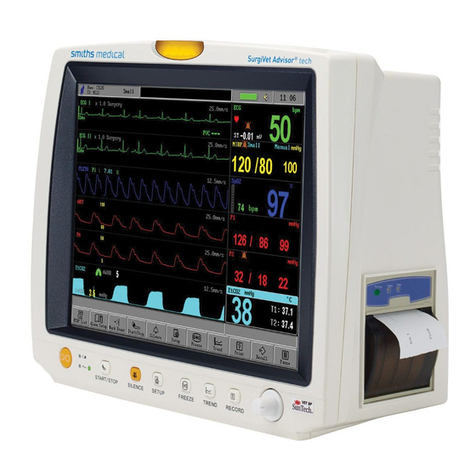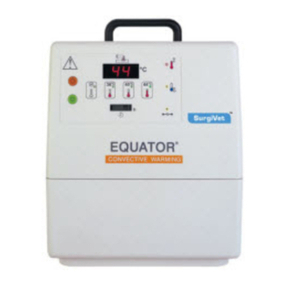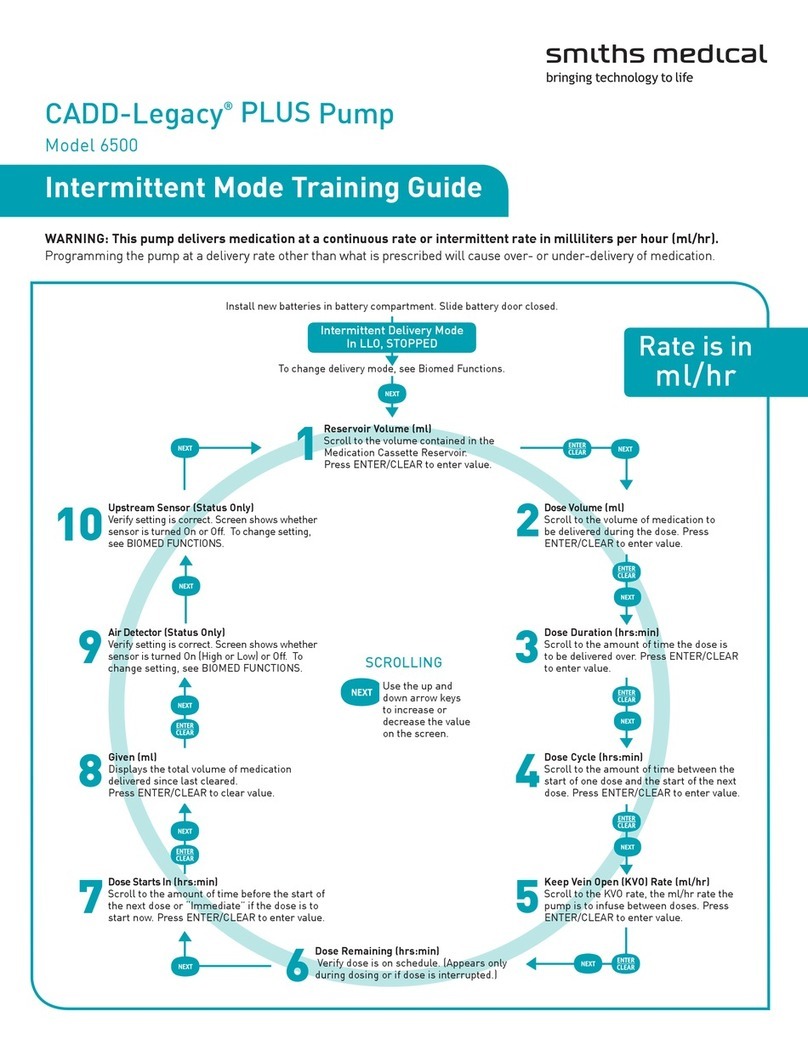
Smiths Medical is part of the global technology business Smiths Group plc. acapella and
the Portex and the Smiths Medical design marks are trademarks of Smiths Medical. The
symbol ® indicates the trademark is registered in the U.S. Patent and Trademark Office
and certain other countries. All other names and marks mentioned are the trademarks
or service marks of their respective owners. ©2014 Smiths Medical. All rights reserved.
RE194319EN-102014 MKEECA-0060
Smiths Medical ASD, Inc.
Keene, NH 03431, USA
Phone: +1-603-352-3812
Toll-Free USA 1-800-258-5361
www.smiths-medical.com
5. PRECAUTIONS:
5.1 Bleach is not recommended for use on the acapella®duet. It may
deteriorate the nickel plated mechanism located in the interior of the
device.
5.2 DO NOT MICROWAVE. The metal and magnet might ignite.
5.3 It is the responsibility of the user to ensure all sterility verification(s).
5.4 Visually inspect the device to ensure that the unit is free of contamination
and foreign objects.
5.5 Verify all connections are secure.
6. SUGGESTED INSTRUCTIONS FOR USE:
6.1 Initial Settings:
6.1.1 If this is the first use of the acapella®duet device, ensure that the
frequency adjustment dial is turned to the lowest frequency-resistance
setting, indicated at “1”. (See Figure 2)
6.1.2 If desired, attach reservoir tubing to the end of the device. (See Figure 3)
6.1.3 Inject prescribed medications into the SVN.
6.1.4 Connect oxygen tubing to the fitting on the base of the SVN.
6.1.5 Connect the other end of the oxygen tubing to a gas supply.
6.1.6 Attach the SVN to the port on the underside of the acapella®duet body
and turn on gas supply in accordance with SVN instructions. (See Figure 4)
6.1.7 Instruct the patient to relax and take slow deep breaths with a breath
hold (2-3 seconds). The inspired volume should be larger than normal
tidal volume (but not total lung capacity).
6.1.8 Direct the patient to exhale to Functional Residual Capacity (FRC)
actively, but not forcefully through the device.
6.1.9 The patient should be able to exhale for 3-4 seconds as the device vibrates.
a. If the patient cannot maintain an exhalation for this length of time,
adjust the dial towards the plus sign to increase resistance.
b. Increasing the resistance of the vibrating orifice will allow the patient
to exhale at a lower flow-rate.
6.1.10 Selection of the proper resistance range produces the desired
inspiratory to expiratory (I:E) Ratio of 1:3 to 1:4.
a. Note: If the desired resistance and I:E ratio cannot be achieved,
consider the use of an alternate acapella®duet device designed for
different flow ranges.
b. Once the proper range has been identified, the patient may be instructed
to exhale harder or softer, or dial adjustments may be made to optimize
the response that the user “feels” from the vibratory pressure.
c. Several uses may be needed to ensure that individual patient needs
are being met.
6.2 Procedure for the User:
6.2.1 Ensure the adjustment dial is set to the correct range as identified by
your clinician.
6.2.2 If desired, attach reservoir tubing to the device.
6.2.3 Place prescribed medication into the SVN.
6.2.4 Connect oxygen tubing to the fitting on the base of the SVN.
6.2.5 Connect the other end of the oxygen tubing to a gas supply.
6.2.6 Attach the SVN to the port on the underside of the acapella®duet body
and turn on gas supply in accordance with SVN instructions.
6.2.7 Sit with elbows resting comfortably on table.
6.2.8 Place mouthpiece lightly in mouth.
6.2.9 Be sure to maintain a tight seal on the mouthpiece during exhalation.
6.2.10 Your clinician may recommend the use of a nose clip, if necessary.
6.2.11 If using a mask, apply mask tightly but comfortably over nose and mouth.
6.2.12 Take slow deep breaths, as directed by your clinician, taking in a
larger ‘than normal breath, but not filling your lungs to capacity.
6.2.13 Hold your breath for 2-3 seconds.
6.2.14 Exhale actively, but not forcefully, through the device. Exhalation should
last approximately 3 to 4 times longer than inhalation.
6.2.15 Perform 20 PEP breaths (or until medication has completely been
nebulized) as recommended by clinician.
6.2.16 Remove mouthpiece (or mask) and perform 2-3 “huff” coughs to raise
secretions, as needed. Your clinician may direct you on proper cough
technique.
7. CLEANING AND DISINFECTING INSTRUCTIONS:
Precaution: Bleach is not recommended for use on the acapella®duet.
It may deteriorate the nickel plated mechanism located in the interior of
the device.
7.1 There are four parts to clean:
A. the mouthpiece B. the cover C. the rocker D. the base unit.
7.2 Disassembly:
7.2.1 Detach mouthpiece or mask. (See Figure 5)
7.2.2 Detach the cover by placing your forefinger and thumb on the surface
where the internal ribs are located on the unit toward the mouthpiece.
7.2.3 Gently press on the surface and lift the cover up.
NOTE: The cover should only be lifted to a 90° angle. (See Figure 6)
7.2.4 Detach the rocker by placing your forefinger and thumb on either side
of the grooved surface and gently lift the rocker up. (See Figure 7)
7.2.5 Detach CAP & TETHER by removing from SVN port on bottom of
main body.
7.3 Cleaning/Disinfecting Instructions
As per the Cystic Fibrosis Foundation’s cleaning and disinfecting guide-
lines entitled, “Respiratory, Stopping the Spread of Germs” 2008, below are
the guidelines for acapella®duet.
Note: acapella®duet is for single-patient use
PRECAUTIONS:
It is the responsibility of the user to ensure all sterility verification(s).
Smiths Medical recommends cleaning on a regular basis, or right after
each use, especially if used in conjunction with a nebulizer. Always clean
your hands first.
7.3.1 Cleaning: This should be done prior to Disinfecting (7.3.2)
Cleaning with Liquid Dish Detergent:
As needed, detach mouthpiece (mask) then soak the device and mouth-
piece in warm, soapy water as required to remove visible contami-
nants. Use a liquid dish detergent (Dawn®or equivalent), mixing two (2)
tablespoons of detergent per one (1) gallon water. Rinse thoroughly with
sterile water, and allow parts to air dry.
Drain the device by placing it in a normal resting posiiton. (See Figure 5)
7.3.2 Disinfecting:
• Boiling –Boil device in water (100°C/212°F) up to twice daily for five (5)
minutes. In addition, Smiths Medical suggests the use of distilled or
sterile water to lessen the potential of local community, mineral-rich
tap waters from calcifying acapella®duet’s metallic components.
• Autoclaving – acapella®duet will functionally withstand autoclaving at
temperatures not to exceed 136°C/277°F for a maximum of 30 cycles.
• Automatic Dishwasher – acapella®duet is dishwasher safe. It is
recommended to place the parts on the top shelf.
• Alcohol – Soak five (5) minutes, twice daily. acapella®duet is
compatible with 70% isopropyl alcohol. Rinse with sterile water. You
can make water sterile by boiling for five (5) minutes.
• Hydrogen Peroxide –Soak in 3% hydrogen peroxide for 30 minutes.
Rinse with sterile water. You can make water sterile by boiling for five
(5) minutes.
• Control III Disinfectant Germicide –Follow the manufacturer’s
suggested dilution and soak time duration criteria.
• Glutaraldehydes (Cidex®or equivalent) – acapella®duet will maintain
its integrity using cold sterilizing solutions such as glutaraldehydes.
7.4 Reassembly:
7.4.1 Put rocker assembly/platform base back into the base unit. Make sure
it is firmly seated by gently pressing rocker assembly down (fingers
gripping the sides of rocker assembly).
7.4.2 Attach the cover by placing it back into hinges of base unit. Place cover
onto its original position. Make sure you hear a “click” to ensure it is
attached securely.
7.4.3 Attach mouthpiece by slightly pressing the top and bottom of unit
together while you slip on mouthpiece.
8. DISPOSAL:
Dispose of acapella®duet in a safe manner according to Federal/State/
Local regulations and guidelines for disposal of contaminated medical
waste.
9. ESTIMATED DEVICE LIFETIME:
Assuming the manufacturer recommended cleaning protocol is
followed, the acapella®duet device should have a useful life of six (6)
months under normal and customary usage.
The six (6) month usage duration is measured from the date of initial use.
acapella® duet Contents Quantity
Reference Number Per Case
REF 27-9000 acapella®duet, mouthpiece, 10
SVN, oxygen tubing, flex tubing
REF 27-9001 acapella®duet and 10
mouthpiece only
PRODUCT(S) DESCRIBED MAY NOT BE LICENSED OR AVAILABLE FOR SALE IN CANADA AND OTHER COUNTRIES
Caution • Latex Free • Do not use if package is damaged • Non-sterile
• Contains or Presence of Phthalate: bis(2-ethylhexyl) phthalate (DEHP)
[www.smiths-medical.com/phthalates] • Catalogue Number • Batch Code
• Date of Manufacture
Caution: Federal (U.S.A.) law restricts this device to sale by or on the order of
a physician. SINGLE PATIENT USE
f ~ : ; ‚ < = J 26
